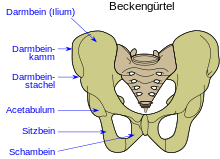Iliac bone
The iliac ( Latin ilium ; also briefly Ilium ) is a flat bone and the bones of the pelvis .
human
The iliac bone is widened like a shovel to form the iliac shovel ( Ala ossis ilium ), hence the name "pelvic shovel". Their free edge is called the iliac crest or iliac crest ( crista iliaca ). It runs into the large anterior iliac spine ( spina iliaca ventralis or spina iliaca anterior superior ). This palpable sting is an important point of orientation for therapists (for localizing the McBurney point , Lanz point , delimitation of the groin region ) and the starting point of many muscles and the inguinal ligament . Two more bony protrusions follow below, the tuberculum iliacum ( spina iliaca anterior inferior ) and the eminentia iliopubica ( iliopectinea ). A bone ridge ( Linea arcuata ) runs on the inside of the iliac blade and leads to an articular surface ( Facies auricularis ) reminiscent of an ear , which forms the sacroiliac joint with the sacrum . The outside of the ilium serves as the facies glutaea, the origin of the gluteal group .
The lower part of the ilium is the iliac column ( Corpus ossis ilium ) and together with the other two hip bones ( pubis and ischial ) the acetabulum ( acetabulum , literally "Essignäpfchen" since it to the acetabulum is reminiscent of the Romans).
Remaining mammals
In quadruped mammals, the iliac blade points upwards and forwards. The cusp located inwards towards the spine is known as the sacral cusp ( tuber sacrale ). It bears the auricular face for the sacroiliac joint. The outward protrusion is called the hip hump ( tuber coxae ).
On the inside of the iliac column, the arcuate line runs to the eminentia iliopubica , where the iliac bone borders the pubic bone . In animals, the ischiadaca major and the ischiadic spine (see ischium ) are parts of the iliac column .
As in humans, the acetabulum is formed by all three pelvic bones.
literature
- F.-V. Salomon: Bony skeleton , in: Salomon, F.-V. u. a. (Ed.): Anatomie für die Tiermedizin, Enke-Verlag, Stuttgart 2004, pp. 37–110, ISBN 3-8304-1007-7 .
